Endangered Species Success Stories
Air Date: Week of January 3, 2020
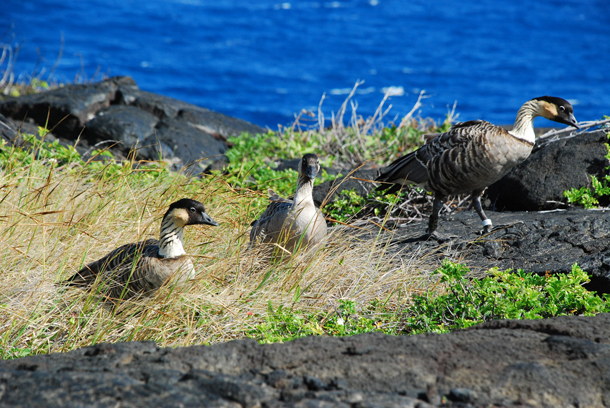
Nene geese at Hawaii Volcanoes National Park. The species is being downlisted from endangered to threatened thanks to successful recovery efforts. (Photo: Sean Hagen, Flickr CC BY-SA 2.0)
2019 brought both good news and bad news for endangered species. While the Trump Administration finalized changes to the Endangered Species Act that could slow species’ recovery, several endangered species have bounced back thanks to the ESA, and a few others just received much-needed protections. Tierra Curry of the Center for Biological Diversity tells Living on Earth’s Jenni Doering about the mostly good news for endangered species in the U.S. that 2019 brought.
Transcript
CURWOOD: It’s Living on Earth, I’m Steve Curwood.
The Endangered Species Act is credited with saving dozens of animals from the brink of extinction, though the Trump administration moved to weaken some rules under the act last year, which would make it harder to protect wildlife at risk. Despite that, there have been some positive developments when it comes to protecting endangered wildlife in 2019. Living on Earth’s Jenni Doering asked Tierra Curry, senior scientist at the Center for Biological Diversity to take a look back at 2019 in terms of wildlife conservation.
CURRY: Well, I'm hoping today we can focus on all the good news and ignore the bad news and make this a happy program. So a lot of not cool stuff happened with this administration and the Endangered Species Act this year. But there were quite a few success stories of species that their populations rebounded, protections were put in place for them and so much though, they're going to come off the list now. So that's great. One of those is a bird called the interior least tern. And it's the smallest tern species. It's black and white. And because it's in so many places, people have a good chance of seeing it. It ranges from the Dakotas down to Texas and over on the coasts. And it's a little bird that likes big rivers; it needs open sandbar habitat. And so, when we started doing flood control on the rivers and damming them and just manipulating the flows, a lot of the sandbars got drowned out and so the interior least turned declined. In 1985, there were less than 2,000 of them, but after it was protected under the Endangered Species Act now there's more than 18,000 of them. So that's a really happy success story. And it's proposed for delisting now.
DOERING: Wow. So I guess that means the Endangered Species Act can really work.
CURRY: It can, 99% of the species that are protected under the Act haven't gone extinct. And so getting on the act, although it's bad news that a plant or animal needs to be added to it, it's good news because it means it's actually going to get the protections it needs to recover. And so this, all of these de-listings bring the total number of species recovered under the Endangered Species Act up to 46. Which doesn't sound like that many. But if you think about it, by the time of species gets put on the list, it's declined so much that it's going to be difficult to recover the population. And it's only been a couple of decades since the Act was put into place. And so now we're seeing these protections that have had time to recover the populations. They did it and it worked and so species can come off the list now.
DOERING: What are some other animals that have been delisted this year?
CURRY: Another species that came off the list this year is the Kirtland’s warbler. It's a beautiful black and yellow bird lives in Michigan and Wisconsin and overwinters in the Bahamas. It was among the first species to be protected under the Act back in 1967. And by 1987, there were fewer than 200 singing males. But now there's more than 2,300 singing males. And this bird is a little bit weird in that it won't nest in trees that are more than 15 years old. And nobody knows why. But it just really likes this young habitat. And so when the land was wilder and there were glaciers moving here and there or fires burning here and there, there were always like young trees, but now they have to maintain, actively maintain, young habitat for it and also control cowbirds because cowbirds are these parasitic birds that lay their eggs in other birds’ nests. And then the Kirkland’s warblers were raising the cowbirds instead of their own nestlings. And so the Fish and Wildlife Service actively maintains their habitat, controls cowbirds and it allowed the Kirtland’s warbler to rebound and so it was delisted this year because it's recovered.
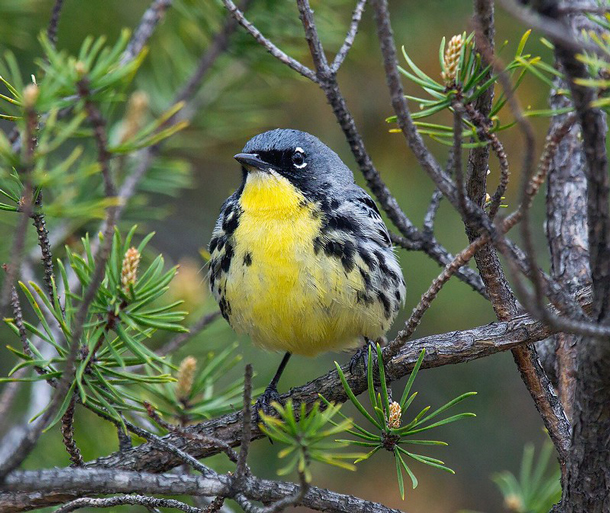
The Kirtland’s warbler is another Endangered Species Act success story. The little songbird no longer needs protection under the ESA, the U.S. Fish and Wildlife Service announced in 2019. (Photo: Doug Greenberg, Flickr CC BY-NC 2.0)
DOERING: Good news for the Kirtland’s warbler. Any other good news for species?
CURRY: Yes, there was a lot of good news for endangered species this year. The nene, which is the Hawaiian goose that has been downlisted from endangered or threatened. In the 1950s, there were fewer than 30 Hawaiian geese left because of hunting and because of introduced predators that were eating them and their babies because their ground nesting birds, so it was also protected in 1967, less than 30 birds left, and there's this great story in 1962 a Boy Scout troop hiked with these cardboard backpacks with 35 of these geese. They hiked 10 miles into Haleakala crater on Maui, because it was a safe habitat for them. And so that happened and then a lot of other restoration and predator control has happened for them and now there's 2,800 of them. So from 30 to 2,800, and they're being down listed to threatened this year.
DOERING: Wow. So these Boy Scouts hiked with cardboard boxes to go give them a safe nesting place for these nene Hawaiian goose.
CURRY: Yes. And I think that must have been so stressful. I'm so clumsy, I would have tripped and fallen in the crater. So I'm glad it wasn't me. I'm glad that they, they successfully carry these birds 10 miles over rocky ground to a fresh start.
DOERING: Wow, rocky volcanic terrain. That's amazing.
CURRY: It is amazing. And if people Google that, like, Hawaiian goose and Boy Scouts, there's these great old black and white pictures of them with their cardboard backpacks carrying the geese.
DOERING: Did we have any animals added to the list this year? And that means they'll get more protections?
CURRY: Yes, there were only three species added to the list this year, which is a bummer because there's certainly hundreds more species that need protection. But I guess it's good news when anything gets added under this administration. And so there's two stone flies in Glacier National Park. Stone flies are little insects, they need water. And so these particular ones live in glacier melt. And so the western glacier stone fly and the meltwater lednian stone fly were officially added to the Endangered Species Act. They're threatened by climate change. And the Glacier National Park is expected to lose its glaciers by 2030. And when the glaciers are gone, these stone flies are probably going to be gone as well. And so we petition for protection for them about a decade ago and they finally added to the list.
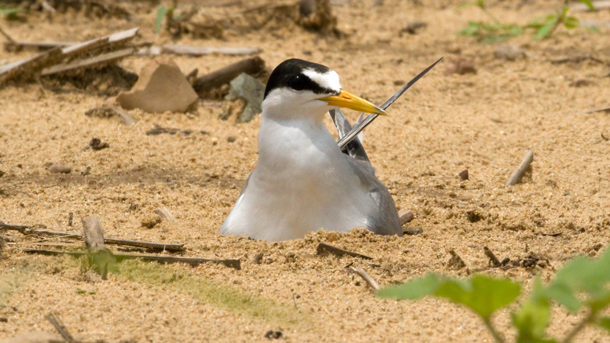
The interior least tern is one of the latest species to be proposed for Endangered Species delisting, given that it has bounced back to about 18,000 individuals, nearly ten times the species’ low point when it was protected as endangered in 1985. (Photo: USFWS Midwest Region, Flickr CC BY 2.0)
DOERING: Well, so I mean, are these flights going to be okay? Even if they do get the protections that could help them but then climate change is going to happen and you know, what's going to happen to them?
CURRY: Well, hopefully them being protected under the Endangered Species Act because they're solely threatened by climate change will raise more awareness of climate change and push this administration and individuals to do more, to fight for policies that will protect these flies and also the human, all the humans on the planet from the effects of climate change which are becoming more and more undeniable every day.
DOERING: It's with us everywhere we go. No matter where we turn.
CURRY: It really is, and to go back to the other species that was protected this year, only three species were protected by the US Fish and Wildlife Service this year. The other one is a really pretty little fish called barrens topminnow that lives in central Tennessee, and it's very blah looking most of the year but during the breeding season, the males turn these crazy bright green glittery colors; it would make a beautiful evening gown. It's like the prettiest iridescent green. And it was actually proposed for listing back in 1977, but didn't get protections till this year. And it used to live in 18 streams but now it only lives in five and a couple of them keep drying up and so scientists have gone to heroic lengths to protect this fish. They keep an eye on its springs and due to increasing drought, when they are going to dry up the scientists go out and collect them and take them into captivity and keep them there until the stream is flowing again. And then they take them back out. And so it would have been lost already if there weren't people who cared about it deeply and went out to protect it. And the Tennessee Aquarium Conservation Institute and this group called Conservation Fisheries, Inc, both have Ark populations of it now so that if it did go extinct in the wild, there would be populations living in captivity that they could take back out again. But hopefully now that it's officially listed, there'll be more funding for its recovery and some habitat protections will be put in place for it.
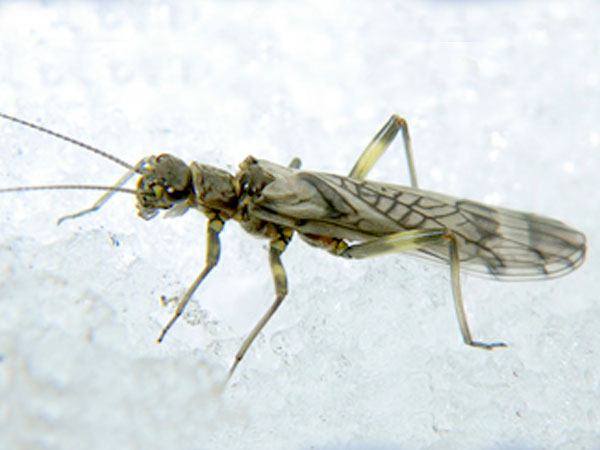
Two species of stoneflies, the western glacier stonefly (above) and the meltwater lednian stonefly, were added to the Endangered Species list in 2019. These flies live in Glacier National Park, where they rely on glacier melt, and as the park could lose its glaciers by 2030 they are expected to be severely impacted by climate change. (Photo: USFWS)
DOERING: Could you tell us about some of the changes that the Trump administration has made to the Endangered Species Act recently? What does that mean for wildlife?
CURRY: So this year, the Trump administration finalized what they call improvements to the Endangered Species Act. One of them: before this year threatened species received the same protections as endangered species, and now threatened species don't receive any protections at all unless a special rule is written for them. And so, like, the Pacific fisher was proposed to be listed as threatened. But its special rule exempts logging. And logging is one of the primary threats to its survival. And so it is a case where the Trump administration improvements to the Endangered Species Act are going to keep the Pacific fisher from getting any on the ground protection from logging unless we can convince them that it should be listed as endangered or that it should have a 4(d) rule that actually protects its habitat. Another change they made is, for when a species gets protected under the Endangered Species Act, it's supposed to get critical habitat for its protection. And the Trump administration has said that for species that are threatened by climate change, they're not going to designate critical habitat for them. And so that is, of course, ridiculous, because, you know, one in three species on Earth is currently threatened by climate change. And that's basically just codifying saying, Hey, we're not gonna do anything about this problem.
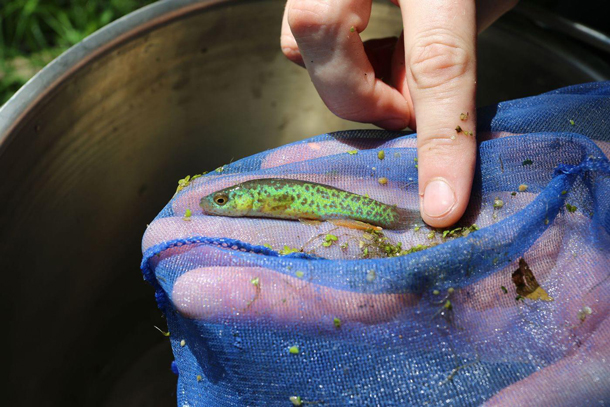
The colorful Barrens topminnow was given ESA protection in 2019. This little fish was proposed for listing all the way back in 1977 and has survived thanks in part to nongovernmental conservation efforts. (Photo: Emily Granstaff, USFWS)
DOERING: So Tierra, we've talked about some of the things that happened for endangered species in 2019. What do you think could be coming up around the corner in 2020?
CURRY: So this year, two big reports came out, one of them from the UN saying that a million species are at risk of extinction. And then a report came out from the International Union for Conservation of Nature last week, saying that one in four species that they assessed are threatened. And so the number of species that are threatened with extinction just continues to grow. And so we need more public awareness of the extinction crisis. We need all of the presidential candidates to be talking about the climate emergency and the extinction crisis. And then we need to rebuild the Endangered Species Act, and we need to fund it. Like we have this tool that can fight extinction in the Endangered Species Act, and it's been consistently underfunded. So it needs a lot more funding, so that we as a country can look around, find all the imperiled species, protect them and figure out how to protect their natural heritage, and I think that protecting these, the species and the habitat they need will also go far and protecting us from the worst impacts of climate change.
DOERING: Yeah, say more about that. Why is there a link between protecting species and ecosystems and, you know, mitigating climate effects?
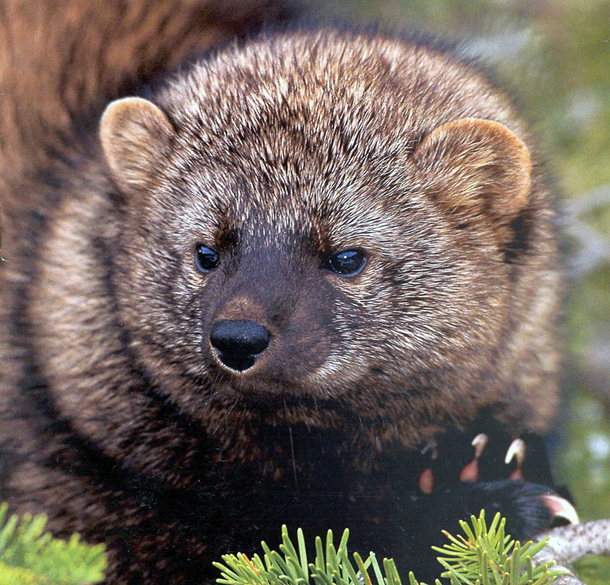
The Trump Administration finalized changes to the Endangered Species Act in 2019, one of which removes some protections for threatened species like the Pacific fisher. (Photo: USFS Region 5, Flickr CC BY 2.0)
CURRY: Well, species need habitat and to fight climate change, scientists have found that like forest and grasslands and wetlands and carbon storage, the soil is like a place where instead of us trying to figure out how to burn coal and then pump those emissions back into the ground, if we just protected intact habitat, that has a huge buffering effect for greenhouse gas emissions, and it will protect the animals that live there. So like national parks and national wildlife refuges, create more of them put stronger protections in place for our national forest and the public lands that we already have. There's been this huge push under the Trump administration to develop fossil fuels on our public lands. And, you know, we and a lot of other groups started this Keep It In the Ground campaign when Obama was president, saying, no more fossil fuel leases on federal lands. And at first was criticized as a crazy idea, like Hillary Clinton herself said this is a crazy idea. Like we're not going to do that. And now all of the candidates are talking about ending fossil fuel leases on federal lands. So that's been a big ground shift that's happened fairly rapidly. And we absolutely need to do that; we need to keep fossil fuels in the ground on federal lands and doing that will protect habitat for tons of endangered species as well.
CURWOOD: That’s Tierra Curry, senior scientist at the Center for Biological Diversity, speaking with Living on Earth’s Jenni Doering.
Links
About the recovery and delisting of the interior least tern
About the recovery and delisting of Kirtland’s warbler
The nene, Hawaii’s state bird, has been downlisted to threatened following recovery
About the western glacier stonefly, listed as endangered in 2019
About the meltwater lednian stonefly, also listed as endangered in 2019
The Barrens topminnow has also been listed as endangered
About the Endangered Species Act rollback
Trump Administration statement on its Endangered Species Act updates
Living on Earth wants to hear from you!
Living on Earth
62 Calef Highway, Suite 212
Lee, NH 03861
Telephone: 617-287-4121
E-mail: comments@loe.org
Newsletter [Click here]
Donate to Living on Earth!
Living on Earth is an independent media program and relies entirely on contributions from listeners and institutions supporting public service. Please donate now to preserve an independent environmental voice.
NewsletterLiving on Earth offers a weekly delivery of the show's rundown to your mailbox. Sign up for our newsletter today!
 Sailors For The Sea: Be the change you want to sea.
Sailors For The Sea: Be the change you want to sea.
 The Grantham Foundation for the Protection of the Environment: Committed to protecting and improving the health of the global environment.
The Grantham Foundation for the Protection of the Environment: Committed to protecting and improving the health of the global environment.
 Contribute to Living on Earth and receive, as our gift to you, an archival print of one of Mark Seth Lender's extraordinary wildlife photographs. Follow the link to see Mark's current collection of photographs.
Contribute to Living on Earth and receive, as our gift to you, an archival print of one of Mark Seth Lender's extraordinary wildlife photographs. Follow the link to see Mark's current collection of photographs.
 Buy a signed copy of Mark Seth Lender's book Smeagull the Seagull & support Living on Earth
Buy a signed copy of Mark Seth Lender's book Smeagull the Seagull & support Living on Earth

